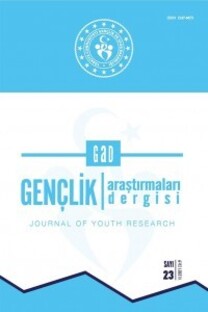Gençler İçin Sistematik Bir Akran İlişki Modeli Olarak Mentörlük
Mentörlük, Risk Altındaki Gençler, Toplumsal Entegrasyon
___
- Arnett, J. J. (2006). Emerging Adulthood: Understanding the New Way of Coming of Age. In J. J. Arnett & J. L. Tanner (Eds.), Emerging adults in America: Coming of age in the 21st century (pp. 3-19). Washington, DC, US: American Psychological Association. http://dx.doi.org/10.1037/11381-001
- Aslan, B., ve Öcal, S. D. (2012). A Case Study in a Teacher Development Program, Journal of Education and Future, 2, s. 31-48.
- DuBois, D. L. ve Neville, H. A. (1997). Youth Mentoring: Investigation of Relationship Characteristics and Perceived Benefits. Journal of Community Psychology, c. 25, sa. 3, s. 227-234.
- DuBois, D. L., Holloway, B. E., Valentine, J. C., ve Cooper, H. (2002). Effectiveness of Mentoring Programs for Youth: A Meta-analytic Review. American Journal of Community Psychology, c. 30, sa. 2, s. 157–197.
- DuBois, D. L., Portillo, N., Rhodes, J. E., Silverthorn, N., ve Valentine, J. C. (2011). How Effective Are Mentoring Programs for Youth? A Systematic Assessment of the Evidence, Psychological Science, c. 12, sa. sa. 2, s. 57-91.
- DuBois, D. L., ve Rhodes, J. E. (2006). Introduction to the Special Issue: Youth Mentoring: Bridging Science wit Practice. Journal of Community Psychology, c. 34, sa. 6, s. 647-655. Fullick-Jagiela, J. M., Klemm Verbos, A., & Wiese, C. W. (2015). Relational mentoring episodes as a catalyst for empowering protégés: A conceptual model. Human Resource Development Review. 14(4) 486–508. DOI: 10.1177/1534484315610730
- Grossman, J. B. ve Rhodes, J. E. (2002). The Test of Time: Predictors and Effects of Duration in Youth Mentoring Relationships. American Journal of Community Psychology, c. 30, sa. 2, s. 199-219.
- Gupta, A. ve Gowda, M.V. R. (2012). Mentoring India’a Youth. IIM Kozhikode Society & Management Review, s. 75-94.
- Hamilton, M. A., & Hamilton, S. F. (2005). Work and service-learning. In D. L. DuBois & M. J. Karcher (Eds.), Handbook of youth mentoring (pp. 348–363).
- Hansford B. ve Ehrich L. C. (2005). The Principalship: How Significant is Mentoring?, Journal of Educational Administration, c. 44, sa. 1, s. 36-52.
- Jeikelek, S., Moore, K. A., ve Hair, E. C. (2002). Mentoring Programs and Yoputh Development: A Synthesis. Washington, D. C.: Child Trends.
- Kavaf, S. (2008). Türkiye’de Ergen Profili 2008 içinde. Mustafa Turgut (ed.)
- Kesen, N. F., Deniz, M. E. ve Durmuşoğlu, N. (2007). Ergenlerde Saldırganlık ve Öfke Düzeyleri Arasındaki İlişki: Yetiştirme Yurtları Üzerine Bir Araştırma. Selçuk Üniversitesi Sosyal Bilimler Enstitüsü Dergisi. Sayı: 17.
- Masten, A.S. & Garmezy, N. (1985) Risk, vulnerability and protective factors in developmental psychopathology. B.B. Lahey ve A.E. Kazdin (Eds.), Advances in Child-Clinical Psychology içinde (Vol. 8, s. 1-52). New York, NY: Plenum Press.
- Munson, R. M., & McMillen, J. C. (2009). Natural mentoring and psychosocial outcomes among older youth transitioning from foster care. Children and Youth Services Review, c. 31, sa. 1, s. 104–111.
- Murrel, A. J. (2007). Five Key Steos for Effective Mentoring Relationships. The Kaitz Quarterly, c. 1, sa. 1, s. 1-9.
- OECD (2016) Society At A Glance 2016: OECD Indicators. A Spotlight on Youth. Paris: OECD Publishing. http://www.oecd.org/social/society-at-a-glance-19991290.htm
- OECD (2017). Education at a Glance 2017: OECD Indicators. Paris: OECD Publishing. http://dx.doi.org/10.1787/eag-2017-en
- Osterling, K. L. ve Hines, A. M. (2006). Mentoring Adolescent Foster Youth: Promoting Resilience During Developmentaş Transitions, Child and Family Social Work, 11, s. 242-253. Ragins, B. R. (2012). Relational mentoring: A positive approach to mentoring at work. In Editors: K. Cameron and G. Spreitzer (Ed.), The oxford handbook of positive organizational scholarship (pp.519-536). Oxford: Oxford University Press. DOI: 10.1093/oxfordhb/9780199734610.013.0039
- Ramani, S., Gruppen, L., ve Kachur, E. K. (2006). Twelve Tips for Developing Effective Mentors. Medical Teacher, c. 28, sa. 5, s. 404-408.
- Rhodes, J. E. (2008). Improving Youth Mentoring Interventions Through Research-based Practice. American Journal of Community Psychology, 45, s. 35-42.
- Rhodes, J. E., Spencer, R., Keller, T. E., Liang, B., ve Noam, G. (2006). A Model fort he Influence of Mentoring Relationships on Youth Develeopment, Journal of Community Psychology, c. 34, sa. 6, s. 691-707. Rhodes, J.E. (1994) Older and Wiser: Mentoring Relationships in Childhood and Adolescence. The Journal of Primary Prevention, 14, s. 187–196.
- Santrock, J. W. (2011). Life-span Development (3rd edition). New York, NY: McGraw-Hill.
- Schwartz, S., Rhodes, J. E., Chan, C., ve Herrera, C. (2011). The Impact of School-Based Mentoring on Youth with Different Relational Profiles. Developmental Psychology, 47, 450–462.
- Smith, C. A., ve Stormont, M. A. (2011). Building and Effective School-Based Mentoring Program, Intervention School and Clinic, c. 47, sa. 1, s. 14-21.
- T.C. Başbakanlık Aile ve Sosyal Araştırmalar Genel Müdürlüğü (2010). Türkiye’de Ergen Profili – 2008. Araştırma Serisi: 147. http://www.aile.gov.tr/tr/23519/Turkiye-Ergen-Profili-Arastirmasi. Ankara: Uzerler Matbaacılık.
- Tierney, J. P., Grossman, J. B. ve Resch, N. L. (2000). Making a Difference: An Impact Study of Big Brothers Big Sisters. Philadelphia: Public/Private Ventures. http://www.ppv.org/ppv/publications/assets/111_publication.pdf
- Tükeltürk, Ş. A. ve Balcı, M. (2014). Üniversitelerde Mentörlüğün Kurumsallaştırılması Süreci, Önemi ve Kazanımları: Çanakkale Onsekiz Mart Üniversitesi Üzerine Bir İnceleme. Organizasyon ve Yönetim Bilimleri Dergisi, c. 6, sa. 1, s. 137-155.
- Türkiye İstatistik Kurumu (2018). İstatistiklerle Gençlik , 2017. 27598 sayı ve 16 Mayıs 2018 tarihli TUİK Haber Bülteni. 20 Haziren 2018’de http://www.tuik.gov.tr den indirildi.
- Uysal, M. P. ve Sığrı, Ü. (2011). E-Mentörlükten E-Öğrenmeye. Birim Balcı Demirci, Gonca Telli Yamamoto ve Uğur Demiray (2011). Türkiye’de E-Öğrenme: Gelişmeler ve Uygulamalar II içinde. Ankara: Elif Yayınevi.
- ISSN: 2147-8473
- Yayın Aralığı: 3
- Başlangıç: 2012
- Yayıncı: T.C. Gençlik ve Spor Bakanlığı Eğitim, Kültür ve Araştırma genel Müdürlüğü
Rekreasyon Bölümü Öğrencilerinin Kariyer Planlama Stratejileri
Kubilay ÖCAL, Mehmet BAYANSALDUZ
Gençlerde Ekonomi Okuryazarlığı Düzeylerinin Belirlenmesine Yönelik Bir Araştırma
Asil ÖZDOĞRU, Mehmet Yunus GÖKALP, Hümeyra KUŞCU
Gençler İçin Sistematik Bir Akran İlişki Modeli Olarak Mentörlük
Atletizm Sporcularının Algıladıkları Antrenör Davranışlarının Çeşitli Değişkenlere Göre İncelenmesi
Türkiye’de Rekreasyon Birimi Yapılanması İçin Sektör Değerlendirmesi
